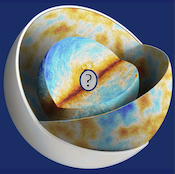Description
https://www.ihp.fr/fr/live-amphitheatre-hermite
I will present the status of the LiteBIRD JAXA mission, after it entered in reformation period since September 2025.
This talk will highlight the LiteBIRD space mission's capability to map the thermal Sunyaev-Zeldovich (SZ) effect, arising from the scattering of CMB photons by hot baryonic gas within and around galaxy clusters. Although primarily designed to search for large-scale CMB B-mode polarization, LiteBIRD will deliver full-sky maps in total intensity with unprecedented sensitivity across 15...
Future satellite missions focusing on the tensor-to-scalar ratio r will likely include a rotating half-wave plate (HWP) device in order to precisely recover the B-mode polarization signal. Patanchon [2023] modeled the effect of HWP systematic imperfections leading to Intensity to Polarization (IP) leakage on the measurement of the B-mode signal. This model is now implemented in the LiteBIRD...
Not long after the Planck space mission launch, it appeared that signals from the detectors operated at 100 mK of one of its instruments, HFI, were affected by cosmic rays. The heat dissipation in the detectors due to these particles hits created spurious signals appearing as glitches in the data. Further post-launch studies have allowed for most of these glitches to be removed.
Several space...
Taurus is a balloon-borne CMB experiment, planning to launch in 2027. It will fly from Wanaka, New Zealand, as the payload of a NASA Super Pressure Balloon in the stratosphere of the Southern Hemisphere, giving it a view of more than half of the sky. By imaging at night for several weeks with its three refractor telescopes, Taurus will map the polarized microwave emission of the sky in four...

